1994 CHEVROLET SUBURBAN heater
[x] Cancel search: heaterPage 72 of 385

3. If this light does not come on, or the instant the light goes off, turn your
ignition key to
START. When the engine starts, let go of the key.
NOTICE:
Holding your key in “Start” for longer than 15 seconds at a time
will cause your battery to be drained much sooner. And the
excessive heat can damage your starter motor.
4. If the engine does not start after 15 seconds of cranking, turn the
ignition key to
OFF. Wait one minute for the starter to cool, then try
the same steps again.
If you’re trying to start your engine after you’ve run out of fuel, follow the
steps
in “Running Out of Fuel” (see “Diesel Fuel Requirements and Fuel
System”
in the Index).
When your engine
is cold, let it run for a few minutes before you move your
vehicle. This lets oil pressure build up. Your engine
will sound louder when
it’s cold.
NOTICE:
If you’re not in an idling vehicle and the engine overheats, you
wouldn’t be there to see the coolant temperature gage. This
could damage your vehicle. Don’t let your engine run when
you’re not in your vehicle.
Cold Weather Starting (Diesel Engine)
The following tips will help you get good starting in cold weather.
Use
SAE low-30 oil when the outside temperature drops below freezing.
When the outside temperature drops below 0°F
(-I S’C), use your engine
coolant heater.
If
you park your vehicle in a garage, you shouldn’t need to use the coolant
heater
until the garage temperature goes below 0°F (-1 Sac), no matter how
cold
it is outside.
2- 17
ProCarManuals.com
Page 73 of 385
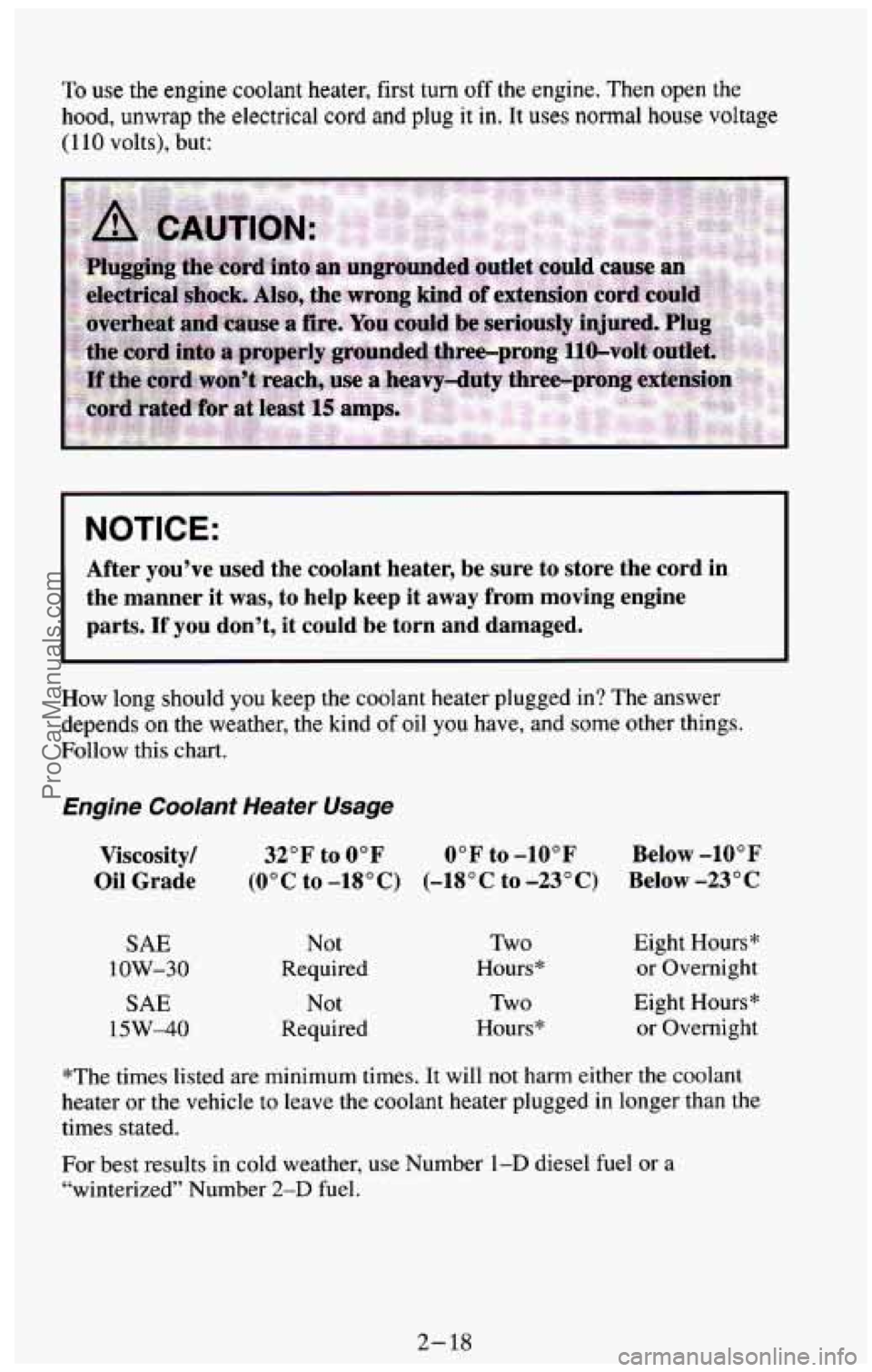
To use the engine coolant heater, first turn off the engine. Then open the
hood, unwrap the electrical cord and plug it in. It uses normal house voltage
(1 10 volts), but:
NOTICE:
After you’ve used the coolant heater, be sure to store the \
cord in
the manner it was, to help keep it away from moving engine
parts.
If you don’t, it could be torn and damaged.
How long should you keep the coolant heater plugged in? The answer
depends
on the weather, the kind of oil you have, and some other things.
Follow this chart.
Engine Coolant Heater Usage
Viscosity/
Oil Grade
SAE
1 OW-30
SAE
15W-40
32°F to 0°F 0°F to -10°F Below -10°F
(o0C to -18°C) (-18°C to-23°C) Below
-23°C
Not
Required
Not
Required Two
Hours*
Two
Hours* Eight Hours*
or Overnight
Eight Hours* or Overnight
*The times listed are minimum times.
It will not harm either the coolant
heater or the vehicle to leave the coolant heater plugged
in longer than the
times stated.
For best results
in cold weather, use Number 1-D diesel fuel or a
“winterized” Number
2-D fuel.
2-18
ProCarManuals.com
Page 74 of 385
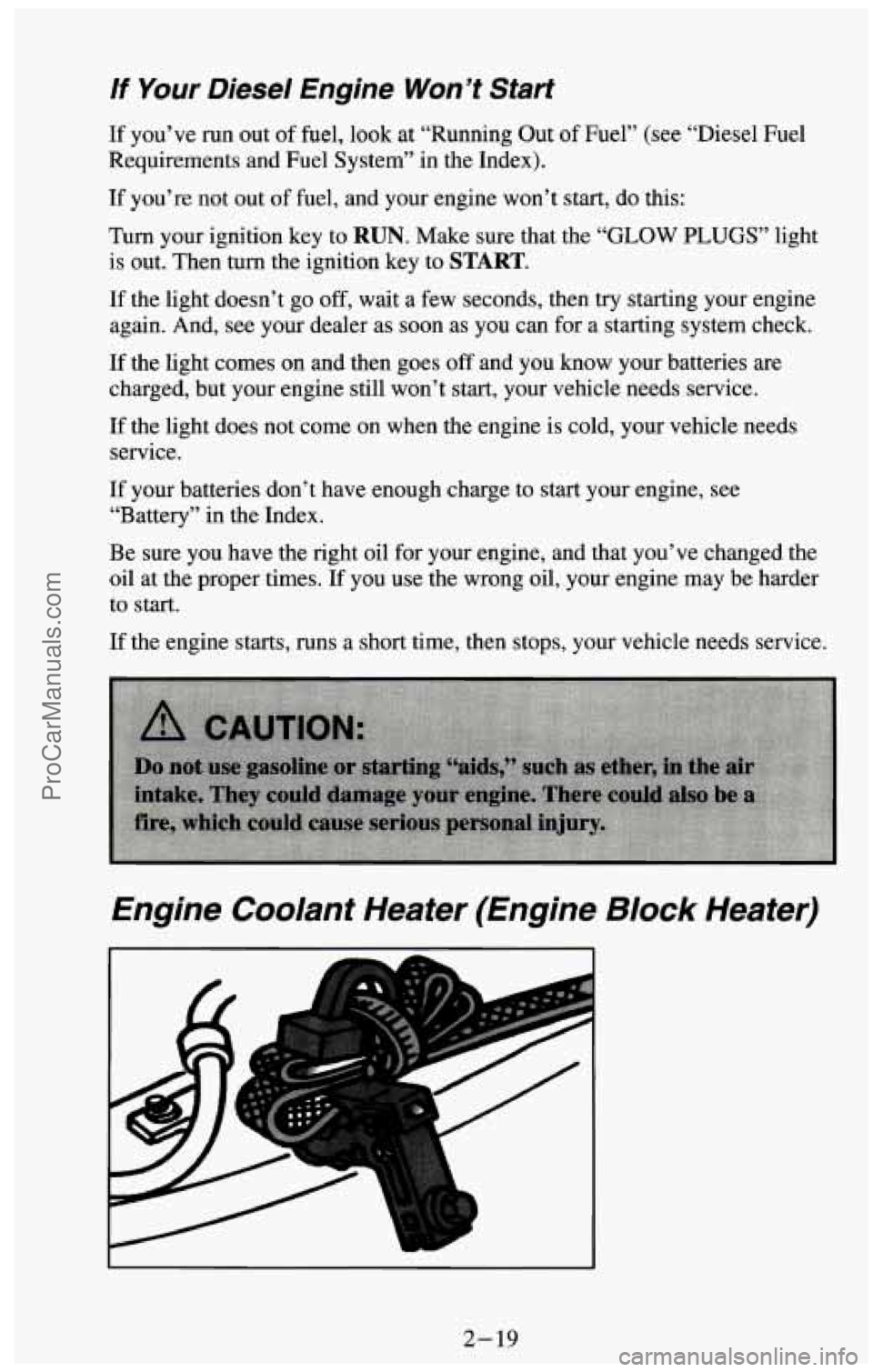
If Your Diesel Engine Won’t Start
If you’ve run out of fuel, look at “Running Out of Fuel” (see “Diesel Fuel
Requirements and Fuel System” in the Index).
If you’re not out of fuel, and your engine won’t start, do this:
Turn your ignition key to RUN. Make sure that the “GLOW PLUGS” light
is out. Then turn the ignition key to
START.
If the light doesn’t go off, wait a few seconds, then try starting your engine
again. And, see your dealer as soon as you can for a starting system check.
If the light comes on and then goes off and you know your batteries are
charged, but your engine still won’t start, your vehicle needs service.
If the light does not come
on when the engine is cold, your vehicle needs
service.
If your batteries don’t have enough charge to start your engine, see
“Battery” in the Index.
Be sure you have the right oil for your engine, and that you’ve changed the
oil at the proper times. If you use the wrong oil, your engine may be harder
to start.
If the engine starts, runs a short time, then stops, your vehicle needs service.
Engine Coolant Heater (Engine Block Heater)
2- 19
ProCarManuals.com
Page 75 of 385
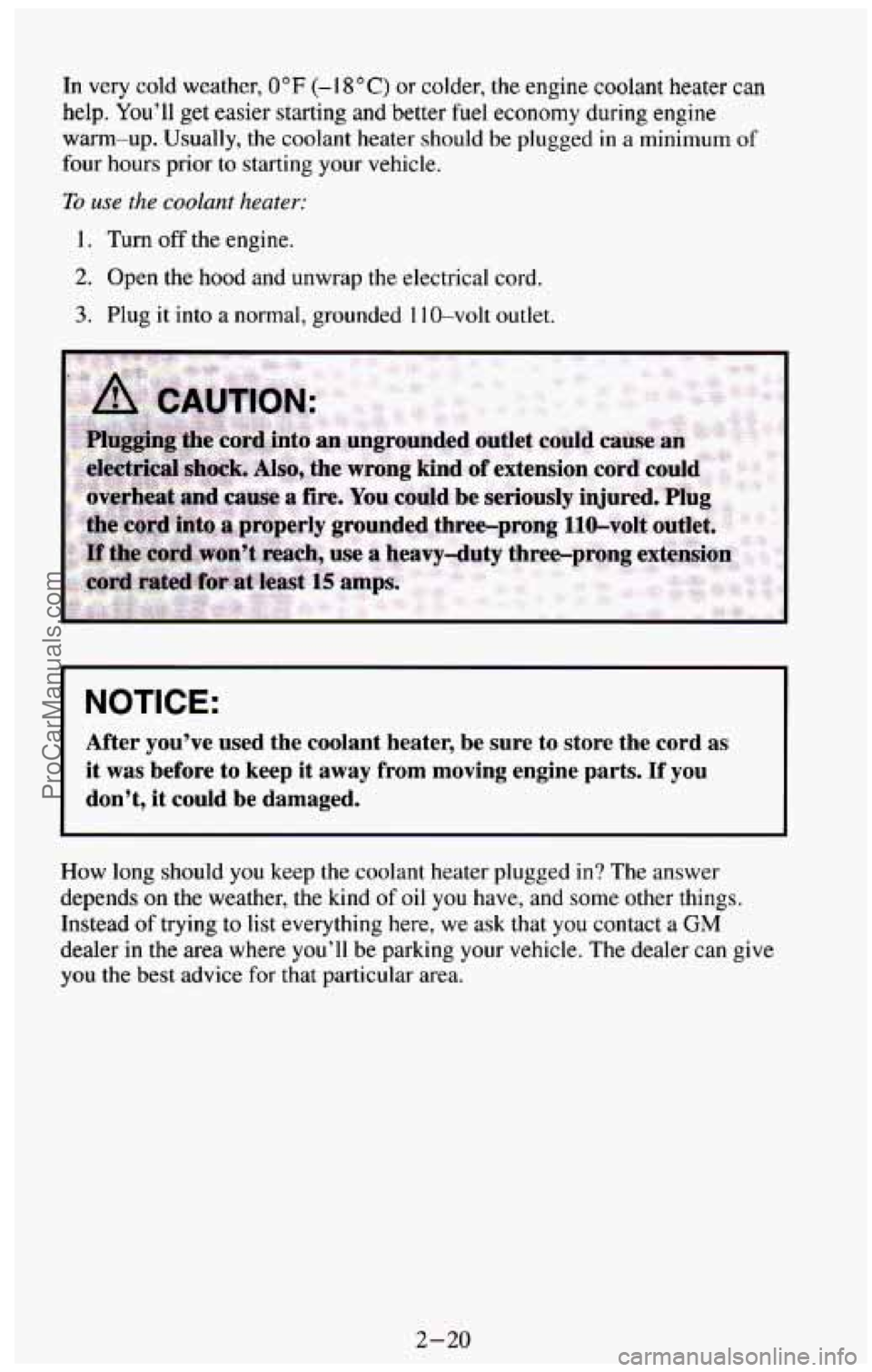
In very cold weather, 0°F (- 1 8 “C) or colder, the engine coolant heater can
help. You’ll get easier starting and better fuel economy during engine
warn-up. Usually, the coolant heater should be plugged in a minimum of
four hours prior to starting your vehicle.
To use the coolant heater:
1. Turn off the engine.
2. Open the hood and unwrap the electrical cord.
3. Plug it into a normal, grounded 1 10-volt outlet.
I
I
NOTICE:
After you’ve used the coolant heater, be sure to store the \
cord as
it was before
to keep it away from moving engine parts. If you
don’t, it could be damaged.
How long should you keep the coolant heater plugged in? The answer
depends on the weather, the kind of oil
you have, and some other things.
Instead
of trying to list everything here, we ask that you contact a GM
dealer in the area where you’ll be parking your vehicle. The dealer can give
you the best advice for that particular area.
2-20
ProCarManuals.com
Page 119 of 385
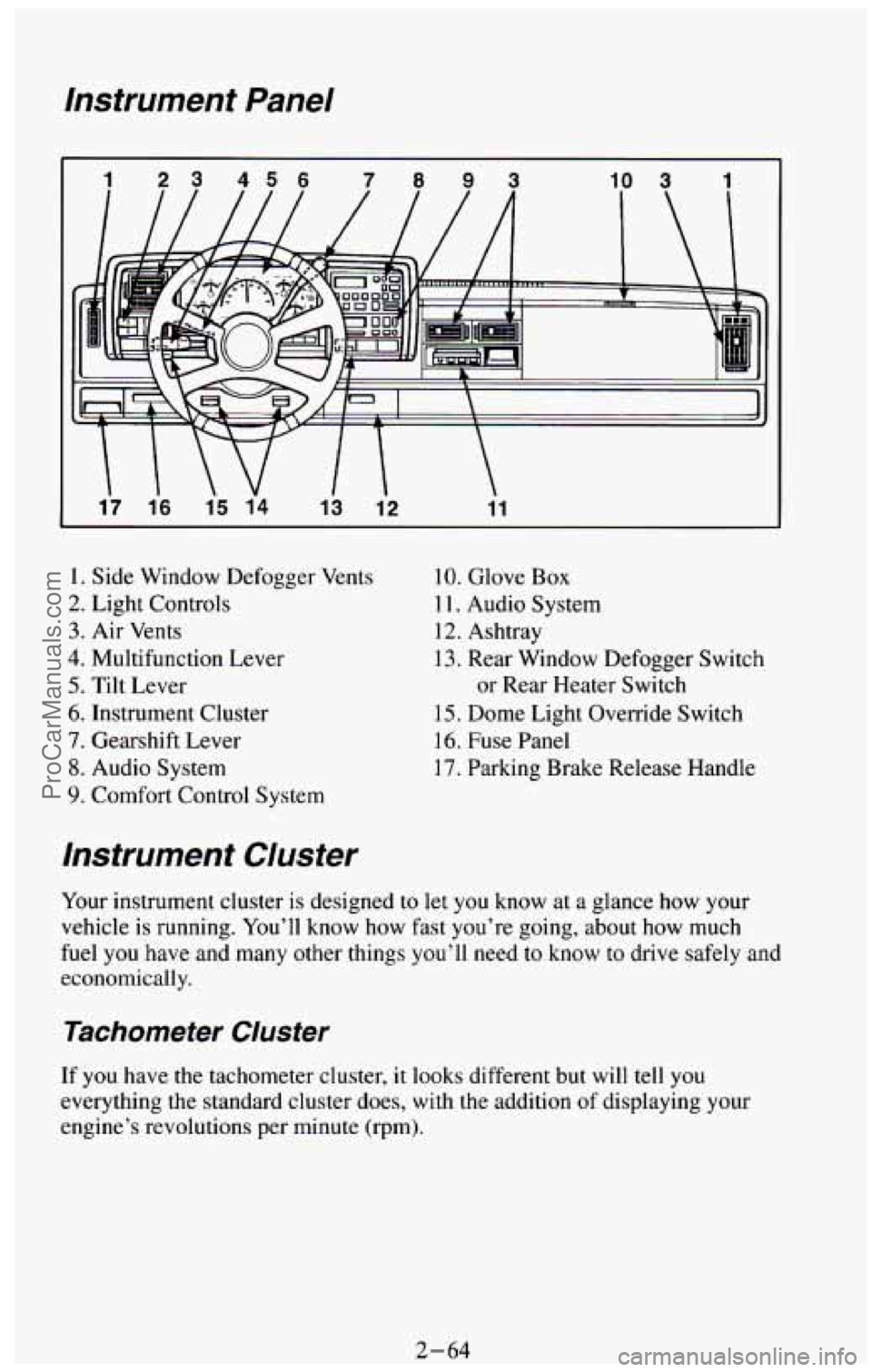
Instrument Panel
13 1’2
1. Side Window Defogger Vents
2. Light Controls
3. Air Vents
4. Multifunction Lever
5. Tilt Lever
6. Instrument Cluster
7. Gearshift Lever
8. Audio System
9. Comfort Control System
10. Glove Box
1 1. Audio System
12. Ashtray
13. Rear Window Defogger Switch
or Rear Heater Switch
15. Dome Light Override Switch
16. Fuse Panel
17. Parking Brake Release Handle
Instrument Cluster
Your instrument cluster is designed to let you know at a glance how your
vehicle is running.
You’ll know how fast you’re going, about how much
fuel you have
and many other things you’ll need to know to drive safely and
economically.
Tachometer Cluster
If you have the tachometer cluster, it looks different but will tell you
everything the standard cluster does, with the addition of displaying your
engine’s revolutions per minute (rpm).
2-64 ProCarManuals.com
Page 139 of 385
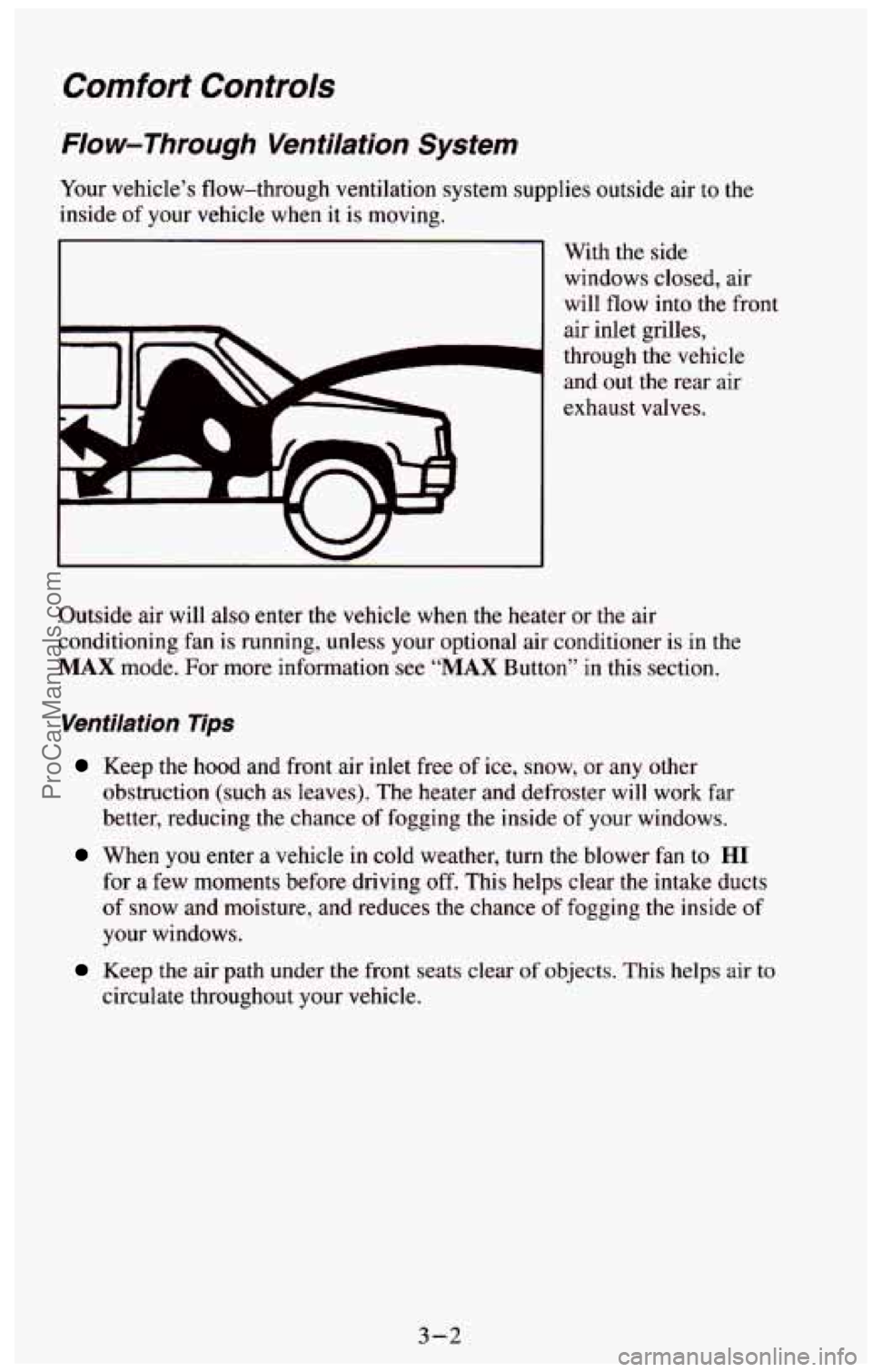
Comfort Controls
Flow-Through Ventilation System
Your vehicle’s flow-through ventilation system supplies outside air to the
inside of your vehicle when it is moving.
I
With the side
windows closed, air
will flow into the front
I
F”
air inlet
through
and out
exhaust grilles,
the
vehicle
the rear air
valves.
Outside air will also enter the vehicle when the heater or the air
conditioning fan is running, unless your optional air conditioner is in the
MAX mode. For more information see “MAX Button” in this section.
Ventilation Tips
Keep the hood and front air inlet free of ice, snow, or any other
obstruction
(such as leaves). The heater and defroster will work far
better, reducing the chance of fogging the inside
of your windows.
When you enter a vehicle in cold weather, turn the blower fan to HI
for a few moments before driving off. This helps clear the intake ducts
of snow and moisture, and reduces the chance of fogging the inside of
your windows.
Keep the air path under the front seats clear of objects. This helps air to
circulate throughout your vehicle.
3-2
ProCarManuals.com
Page 141 of 385
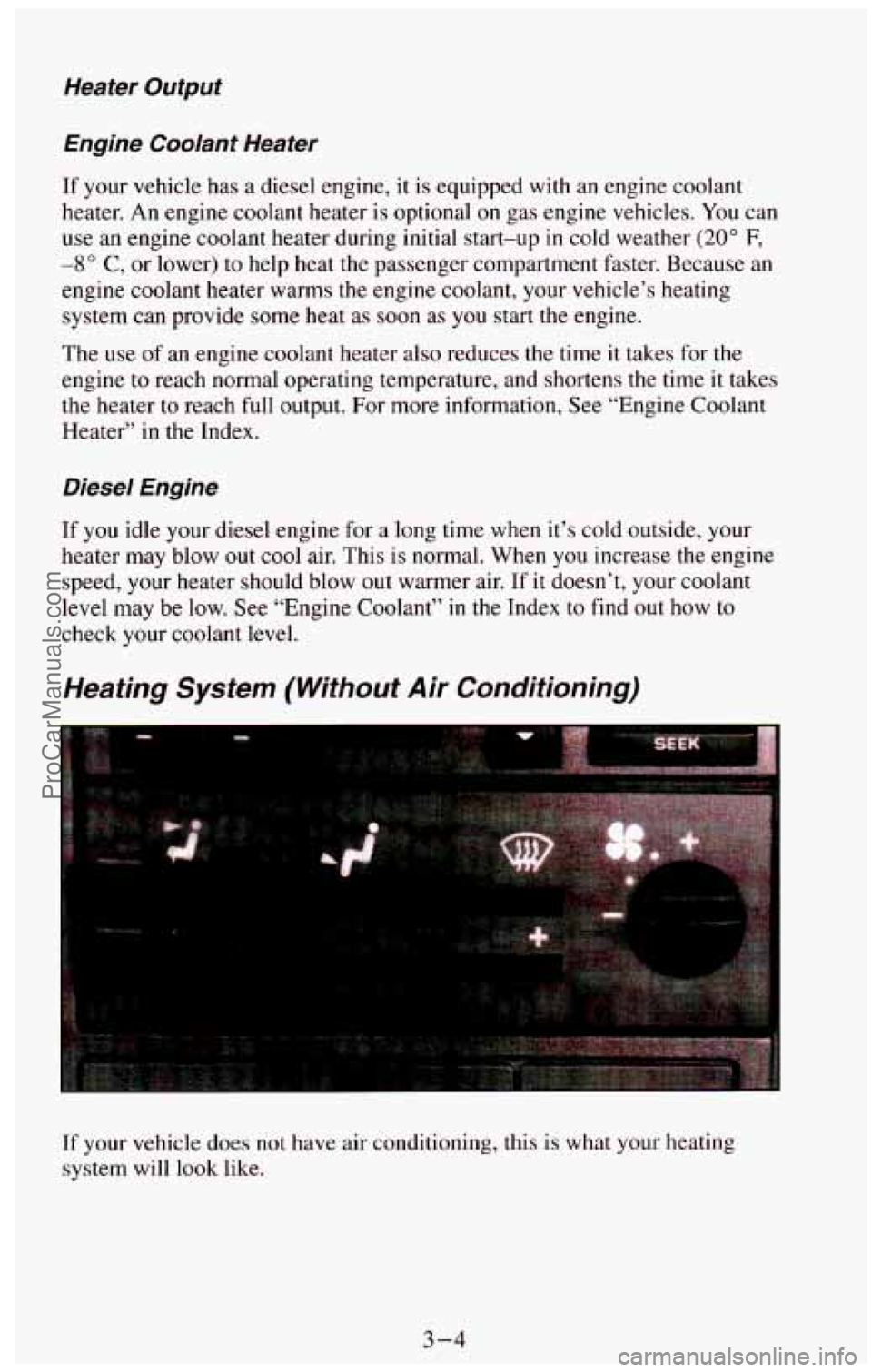
Heater Output
Engine Coolant Heater
If your vehicle has a diesel engine, it is equipped with an engine coolant
heater. An engine coolant heater
is optional on gas engine vehicles. You can
use an engine coolant heater during initial start-up
in cold weather (20” F,
-8” C, or lower) to help heat the passenger compartment faster. Because an
engine coolant heater warms the engine coolant, your vehicle’s heating
system can provide some heat as soon as you start the engine.
The use
of an engine coolant heater also reduces the time it takes for the
engine to reach normal operating temperature, and shortens the time it takes
the heater
to reach full output. For more information, See “Engine Coolant
Heater” in the Index.
Diesel Engine
If you idle your diesel engine for a long time when it’s cold outside, your
heater may blow out cool air. This is normal. When you increase the engine
speed, your heater should blow
out warmer air. If it doesn’t, your coolant
level may be low. See “Engine Coolant”
in the Index to find out how to
check your coolant level.
Heating System (Without Air Conditioning)
If your vehicle does not have air conditioning, this is what your heating
system will look like.
3-4
ProCarManuals.com
Page 142 of 385
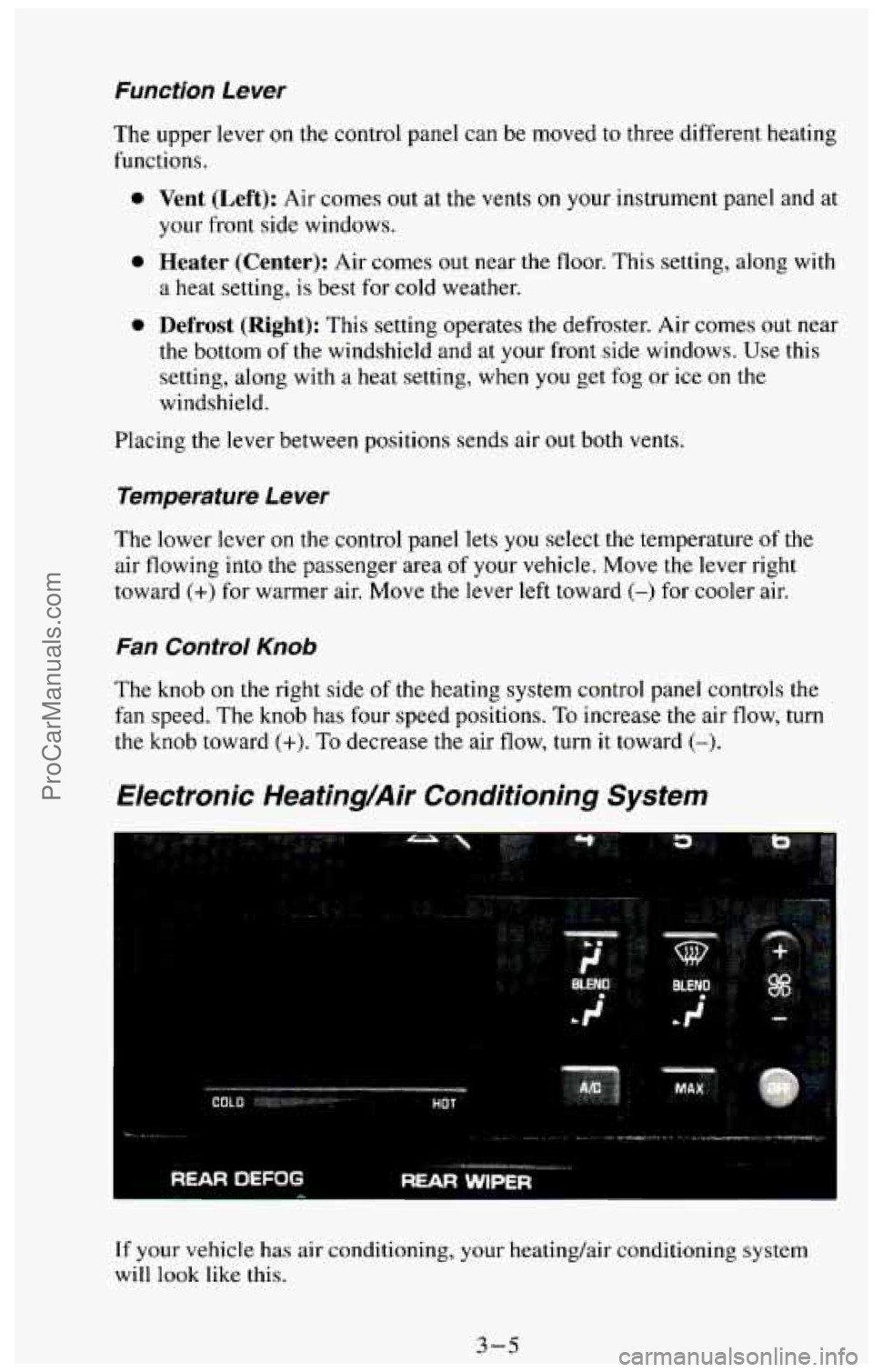
Function Lever
The upper lever on the control panel can be moved to three different heating
functions.
0 Vent (Left): Air comes out at the vents on your instrument panel and at
your front side windows.
a heat setting, is best for cold weather.
0 Defrost (Right): This setting operates the defroster. Air comes out near
the bottom of the windshield and at your front side windows. Use this
setting, along with
a heat setting, when you get fog or ice on the
windshield.
0 Heater (Center): Air comes out near the floor. This setting, along with
Placing the lever between positions sends air out both vents.
Temperature Lever
The lower lever on the control panel lets you select the temperature of the
air flowing into the passenger area
of your vehicle. Move the lever right
toward
(+) for warmer air. Move the lever left toward (-) for cooler air.
Fan Control Knob
The knob on the right side of the heating system control panel controls the
fan speed. The knob has four speed positions. To increase the air flow, turn
the knob toward (+). To decrease the air flow, turn it toward (-).
Electronic Heating/Air Conditioning System
If your vehicle has air conditioning, your heating/air conditioning system
will
look like this.
3-5
ProCarManuals.com